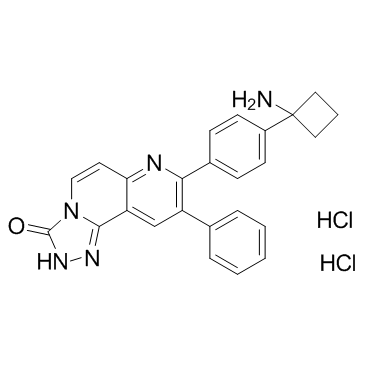1032350-13-2
| Name | mk-2206 |
|---|---|
| Synonyms |
8-[4-(1-Aminocyclobutyl)phenyl]-9-phenyl-1,2,4-triazolo[3,4-f][1,6]naphthyridin-3(2H)-one dihydrochloride
1,2,4-Triazolo[3,4-f][1,6]naphthyridin-3(2H)-one, 8-[4-(1-aminocyclobutyl)phenyl]-9-phenyl-, hydrochloride (1:2) 8-[4-(1-Aminocyclobutyl)phenyl]-9-phenyl[1,2,4]triazolo[3,4-f][1,6]naphthyridin-3(2H)-one dihydrochloride MK-2206 dihydrochloride MK-2206 2HCl MK2206 MK 2206 (dihydrochloride) |
| Description | MK 2206 is an orally active allosteric Akt inhibitor with IC50s of 5, 12 and 65 nM for Akt1, Akt2 and Akt3, respectively. |
|---|---|
| Related Catalog | |
| Target |
Akt1:5 nM (IC50) Akt2:12 nM (IC50) Akt3:65 nM (IC50) Autophagy |
| In Vitro | The NPC cell lines CNE-1, CNE-2, HONE-1, and SUNE-1 are treated with increasing doses of MK-2206 (0-10 μM) for 72 and 96 hours, results in dose- and time-dependent inhibition of cell viability. At 72 and 96 hours, the IC50 values of MK-2206 in CNE-1, CNE-2, and HONE-1 cell lines are 3-5 μM, and in SUNE-1, they are less than 1 μM[1]. MK-2206 alone more potently inhibits the cell growth of Ras wild-type (WT) cell lines (A431, HCC827, and NCI-H292; IC50s of 5.5, 4.3, and 5.2 μM, respectively) as compared with Ras-mutant cell lines (NCI-H358, NCI-H23, NCI-H1299, and Calu-6; IC50s of 13.5, 14.1, 27.0, and 28.6 μM, respectively), with the exception of NCI-H460, which has a PIK3CA E545K mutation (IC50, 3.4 μM)[2]. |
| In Vivo | MK-2206 doses (480 mg/kg once a week and 240 mg/kg three times a week) can inhibit the growth of human CNE-2 xenografts in nude mice. In the two MK-2206 groups, the tumor weights are much lighter than the control group (P<0.01). Temporal body weight reduction is observed after receiving the MK-2206 treatment[1]. |
| Cell Assay | The NPC cell lines CNE-1, CNE-2, HONE-1, and SUNE-1 are seeded into 96-well plates at an appropriate density per well. Twenty-four hours after plating, varying concentrations of MK-2206 (0-10 μM) are added to the wells. Cell proliferation is determined by using the Cell Counting Kit 8 at 72 or 96 hours after dosing. The optical density is measured at 450 nm on an enzyme-linked immunosorbent assay reader. The IC50 value is determined as the concentration resulting in 50% cell growth inhibition after a 72 or 96 hours exposure to the drug compared with untreated control cells. All experiments are performed in triplicate in at least three independent experiments[1]. |
| Animal Admin | Mice[1] Four- to six-week-old male BALB/c nude mice are used. CNE-2 cells at 1×107/mL are suspended in serum-free medium, and 0.2 mL medium is injected subcutaneously into the right flank of each nude mouse. When mean tumor volume reaches approximately 50 mm3, the mice are randomized into three groups (n=7/group) with approximately equivalent ranges of tumor volume between groups. The MK-2206 is dosed with 30% Captisol. MK-2206 (240 mg/kg, three times a week), MK-2206 (480 mg/kg, once a week), and 30% Captisol diluents are administered by oral gavage for 2 weeks for each group. Tumor growth is measured with calipers every other day, and the tumor volume is calculated by the following formula: volume (mm3)=length×width2×0.5. Mice are killed when mean tumor volume in the control group is larger than 2,000 mm3. Harvested tumor specimens are weighed and fixed in 10% buffered formalin and embedded in paraffin. |
| References |
| Molecular Formula | C25H23Cl2N5O |
|---|---|
| Molecular Weight | 480.389 |
| Exact Mass | 479.127960 |
| PSA | 89.07000 |
| LogP | 6.54700 |
| Hazard Codes | Xi |
|---|
